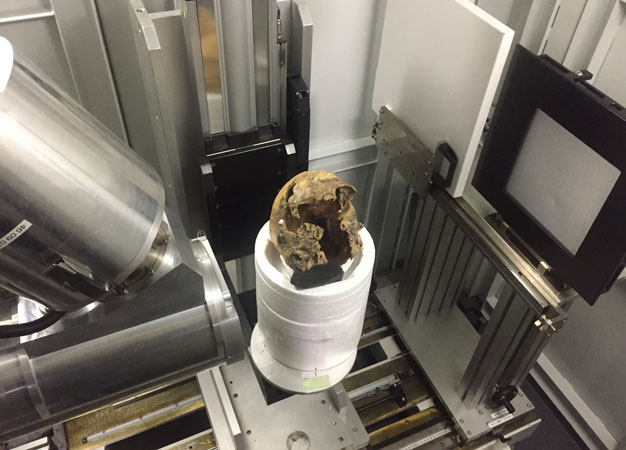By using computed tomography to analyze hominin bones, researchers at Keio are revealing the history of Japan's first inhabitants
Published online 31 January 2018

A half-size, three-dimensional printed restoration model of a Shiraho skull.
© 2018 Reiko Kono, Keio University
Unbeknownst to the many tourists who flock to Ishigaki Island in Okinawa, the island harbors an archaeological site where the story of Japan's first people is being gradually revealed. A limestone cave set slightly back from Shiraho beach has yielded an unprecedented number of bone fragments, which date back more than 20,000 years ― some of the oldest found in Japan.
Analyzing ancient bones using modern technology
We know much less about the first Asians than the early humans of Africa and Europe. Reiko Kono of Keio University's Faculty of Letters is taking advantage of the power of modern technology to improve the effectiveness of excavations in Asia. She is using computed tomography (CT) scanning and three-dimensional (3D) printing to virtually restore the bones of hominins ― modern humans and extinct human species.
Kono begins her 3D virtual restorations with a CT scan. The bone fragments are converted into digital data made up of tiny pixelated cubes and triangular surfaces. Kono then uses this data to determine how the fragments should be pieced together.
"It may be time consuming, but it's a non-invasive way of restoring remains," says Kono. "Printing out and physically touching the restoration model also helps verify that the fragment connections make sense."
Recently, Kono's expertise in 3D restoration has helped advance research in Taiwan1, China2 and Indonesia3. Her models have allowed researchers to confirm that they had found groups of people distinct from other known hominins in Asia.

Doing a three-dimensional computed tomography scan of a Shiraho skull.
© 2018 Reiko Kono, Keio University
She is now applying her technique to sites in Japan. "We know that hominins came to the Japanese archipelago about 40,000 years ago, but we don't know much else about the time before the Jomon period, which started roughly 16,000 years ago," says Kono. "The Shiraho remains will definitely give us much more accurate insight."
One of the Shiraho remains had surfer's ear, a bone growth inside the ear induced by regular exposure to wind and cold water. Two had heavily worn teeth on both the upper and lower jaws, although the teeth on the upper jaw were more worn than those on the lower. These are just some of the details Kono and colleagues are trying to explain in order to understand the Shiraho people's lifestyle.
"One thing we can say for sure is that any information we obtain from the Shiraho bones will provide valuable new insights and be of great importance to the study of human remains in Japan," Kono comments.
Coming face-to-face with the Shiraho people
In addition to illuminating characteristic differences with other human remains in Japan, Kono has her eyes set on another ambitious goal: reconstructing the faces of the Shiraho people.
"The remains from Minatogawa on Okinawa Main Island4 had been the 'industry standard' of what the first Japanese people looked like," says Kono. "The Shiraho bones are now telling us that our ancestors in Japan were also more diverse."
One challenge has been that faces, with small, delicate parts, shatter easily. But this is where 3D scanning can help. "With digital data, it's possible to make mirror images of fragments," says Kono. "If there's a part missing on one side, we can complement it in this way."
The 3D digital restoration of the Shiraho people is nearing completion. In the process, Kono reaches back to the beginning, shedding light on a buried chapter.
About the researcher

Reiko Kono― Associate Professor
Natural Science Courses, Faculty of Letters
Reiko Kono earned her doctorate in anthropology in 2002. She has been researching human evolution at the National Museum of Nature and Science (2002-2017). She specializes in analyzing the three-dimensional morphology of molar teeth of extant and extinct humans and great apes using micro-computed tomography.
Links
References
- Chang, C., Kaifu, Y., Takai, M., Kono, R. T., Grün, R., Matsu'ura, S. et al. The first archaic Homo from Taiwan. Nature Communications 6, 6037 (2015). | article
- Liu, W., Martinón‐Torres, M., Kaifu, Y., Wu, X., Kono, R. T., Chang, C.-H. et al. A mandible from the Middle Pleistocene Hexian site and its significance in relation to the variability of Asian Homo erectus. American Journal of Physical Anthropology 162, 715-731 (2017). | article
- van den Bergh, G. D., Kaifu, Y., Kurniawan, I., Kono, R. T., Brumm, A., Setiyabudi, E. et al. Homo floresiensis-like fossils from the early Middle Pleistocene of Flores. Nature 534, 245-248 (2016). | article
- Kaifu, Y., Fujita, M., Kono, R. T. & Baba, H. Late Pleistocene modern human mandibles from the Minatogawa Fissure site, Okinawa, Japan: morphological affinities and implications for modern human dispersals in East Asia. Anthropological Science 119, 137−157 (2011). | article